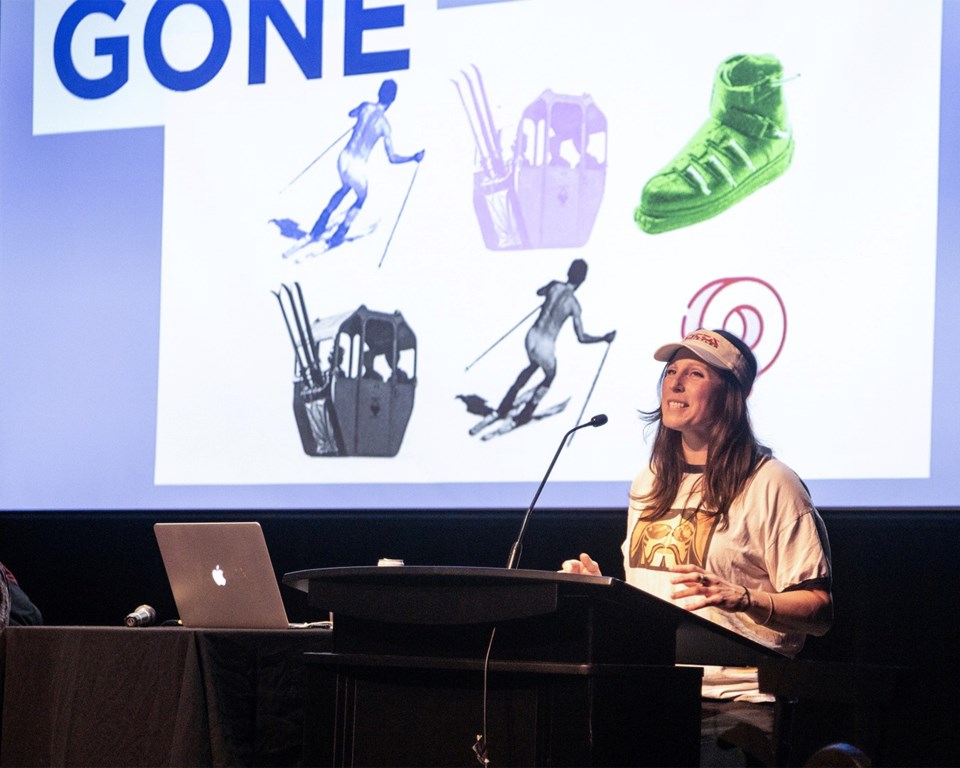As a reporter and a creative in this town, I have spent a not-insignificant amount of time thinking about how to best connect with the young 20-somethings who call Whistler home—if only for a season.
It’s the kind of demographic disconnect that is especially pronounced in a place like Whistler, where the vast majority of young adults in town are here for a good time, not a long time, and therefore less incentivized to venture too far out of their own social circles to connect with the community in a meaningful way.
I was reminded of this last Friday, Jan. 17 at the Whistler Museum’s Icon Gone event, which made its return after a 12-year hiatus. Inviting local personalities to debate in favour of their chosen icon from Whistler’s past, it was the kind of irreverent, occasionally R-rated fun we locals excel at. (Here’s where I confess I was responsible for most of the R-rated content: defending Whistler’s long affinity for nudity, I only had to threaten to expose myself to the crowd a couple times.) And yet, for all the fun that was had, the Maury Young Arts Centre theatre was mostly filled with shocks of silver hair. Now, you might expect the audience to lean older at this kind of historical event—I mean, who better to appreciate Whistler’s past than the people who were actually there for it—but it’s a trend you see in various arenas across Whistler.
Municipal council meetings, sparsely attended affairs as is, tend to only attract younger residents when there is a particularly contentious decision being made that directly impacts them.
It's a challenge RMOW staff and officials acknowledged in October as part of a presentation unveiling the results of the 2024 Community Life Survey, a poll of residents and second homeowners on everything from municipal services and decision-making to housing and community well-being. Typically involving a phone and online poll that reaches hundreds of people every year, the RMOW struggles with getting young, temporary residents to participate.
“We know how many are responding to the online survey and it’s minuscule,” said municipal economic development officer Richard Kemble at the Oct. 8 Committee of the Whole meeting.
That lack of youth engagement means advocacy on issues that impact Whistler’s young adults the most often falls on those in other age and socioeconomic brackets.
“I actually didn’t talk about a single problem that I'm going to face in this community,” a retired homeowner told Pique at an all-candidates meeting ahead of 2022’s municipal election. “My problem will be healthcare as I get older. I'm not going to have a housing issue. I'm not going to have an employee issue. I don't want to own a business because I'm retired. So we brought up problems tonight and discussed things that affect almost nobody in this room.”
I want to be clear here: this isn’t meant to chastise Whistler’s young population (not that they’re likely to read this, anyway). I fully understand there are many other more fun and interesting ways to fill one’s time in Whistler than attending hours-long council meetings or learning about the history of a community you only plan to stay in for a winter or two. And, let’s face it, it’s not easy to make ends meet as a young frontline worker living in one of the costliest communities in the country. Perhaps if young Whistlerites were better taken care of, they’d feel a deeper sense of belonging and would be motivated to contribute to their home away from home in new ways.
In this week’s cover feature about Hillman House, one of Whistler’s oldest and most historically significant buildings, I asked Whistler Museum executive director Brad Nichols about how we’re doing as a community to preserve and share our history. Acknowledging that Whistler’s older generations are “leading the charge” on this front by donating artefacts and sharing stories, he reminded me that we all have a role to play in shaping what will become this town’s history.
“We often forget that history is being made every day,” he said.
It’s this point that often gets lost when considering Whistler’s younger demographics, who I think can feel as though they are not a significant part of this community. Nothing could be further from the truth. For decades, dating back to before Whistler was even Whistler, young adults have formed the lifeblood of our culture, moulding it in their image.
We would be remiss if we didn’t remember that fact.
And for those of us who are young at heart, if not actually young, maybe there’s a youngin’ or two in your life you can bring into the fold. So many young Whistlerites are half a world away from their usual support networks and they could benefit from the kind of wisdom and generosity I know many locals have in spades. Because sometimes the best families are the ones we build ourselves.




